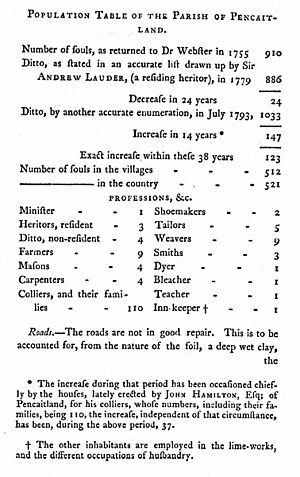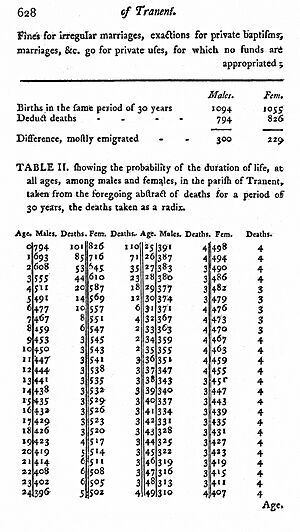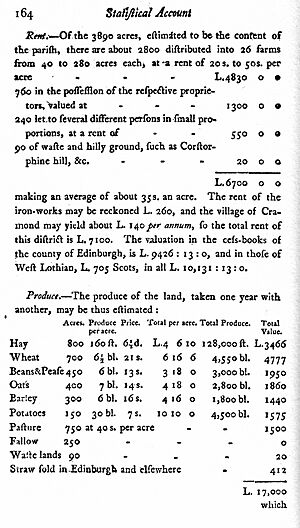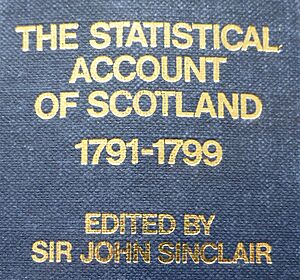Statistical Accounts of Scotland facts for kids
The Statistical Accounts of Scotland are a special collection of books that tell us a lot about life in Scotland. They were published at different times, covering the 1700s, 1800s, and 1900s. Think of them like a huge, detailed report on how people lived, worked, and what the country was like.
The first one, called the Old (or First) Statistical Account of Scotland, came out between 1791 and 1799. It was put together by a person named Sir John Sinclair of Ulbster. The next one, the New (or Second) Statistical Account of Scotland, was published from 1834 to 1845. These first two accounts are amazing records of Scotland during big changes like the Agricultural Revolution (when farming changed a lot) and the Industrial Revolution (when factories and new machines appeared).
A third set of books, the Third Statistical Account of Scotland, was published much later, between 1951 and 1992.
Contents
Early Ideas for a Scottish Survey


People tried to gather information about Scotland's land, people, and economy long before the main accounts. In the 1620s and 1630s, they tried to use the network of about 900 ministers from the Church of Scotland. But there wasn't enough time or money, and the country was going through tough times, like the Civil Wars. So, they didn't get many results.
Sir Robert Sibbald's Efforts (Late 1600s)
Later, Sir Robert Sibbald, who was the official Geographer Royal for Scotland, tried again. Around 1684, he sent out "General Queries" (questions) to parish ministers. But this was also a difficult time because of the Glorious Revolution. Even though some progress was made, the picture of the nation was still very incomplete.
The Church of Scotland's Role (1720–1755)
The General Assembly of the Church of Scotland also wanted a "Geographical Description of Scotland." They worked on this between 1720 and 1744. Again, the country faced problems, including the Jacobite rebellion led by Bonnie Prince Charlie.
However, in 1743, a minister named Rev Robert Wallace organized questionnaires. These were designed to figure out how to help the widows and orphans of clergy (church leaders). This work was important because it helped develop new ways to study populations and plan for the future, which is called actuarial methods. This is why a society for ministers' families was involved in later efforts.
In 1755, another minister, Rev Alexander Webster, created a population count of Scotland. He used some of the information from Wallace's work.
Later Ideas Before Sinclair (1767-1781)
In 1767, Sir James Denham-Steuart suggested a national survey. Then, in 1781, David Erskine, the Earl of Buchan, picked up this idea. But by the time his plan was ready in 1792, it had already been surpassed by the amazing work of Sir John Sinclair of Ulbster.
The First (Old) Statistical Account of Scotland
Sir John Sinclair of Ulbster had studied similar surveys in Germany. He wanted to use these "statistical" methods to understand how happy people were in Scotland. He also wanted to find ways to make life better. He was a great example of the Enlightenment, a time when people believed in using reason and facts to improve society. He focused on gathering real facts. His work is key to understanding Scotland just before the Industrial Revolution and the French Revolution.
In 1790, Sir John sent detailed questionnaires to over 900 parish ministers across Scotland. Each questionnaire had 160 questions, divided into four main parts:
- Geography and the land
- Population (how many people lived there)
- Agricultural and Industrial production (what was grown or made)
- Other questions
He also sent out more questions later. Most ministers responded very well, but the answers varied a lot. For example, the report for Whittingehame parish was 19 pages long with many tables, while Stenton parish only sent 2 pages of basic information. Since some areas didn't respond fully, Sir John sent out "Statistical Missionaries" in 1796 to finish the job. The whole project was done by June 1799. Sir John was then able to present a detailed picture of the nation. These reports are incredibly valuable for understanding history. Some were written by very careful and smart ministers, like the Rev Dr James Meek for the Parish of Cambuslang.
The finished books were published in Edinburgh by William Creech.
The Second (New) Statistical Account of Scotland
As mentioned earlier, the first attempts to gather information about Scotland were linked to helping clergy families. In 1832, a group called the Committee for the Society for the Sons and Daughters of the Clergy decided to continue Sir John's work. They had the support of the General Assembly of the Church of Scotland.
This new account was more modern. It included maps for each county and used the knowledge of local doctors and schoolmasters. It aimed to describe a "new country" because the Industrial and Agricultural Revolutions had changed Scotland so much. It was very much inspired by the "Old Statistical Account." In fact, the minister in charge of the new account for Cambuslang, Rev Dr John Robertson, had been the assistant to the minister who wrote the old account for that same parish!
The Third Statistical Account of Scotland
The Third Statistical Account started in 1947, thanks to a grant of £8,000 from the Nuffield Foundation. It followed a similar format, looking at each parish. The first book, covering Ayrshire, came out in 1951. This account was even more thorough and covered more topics than the earlier ones. It looked at industry, transport, culture, and demographics (the study of populations).
The people editing the volumes tried to make the approach more consistent. However, the spirit of the original accounts was kept, and some unique details remained. This was a huge project. It faced problems with money and finding publishers. Because of these delays, it took over forty years to finish! There was even a gap of more than ten years after the Edinburgh volume was published in 1966. The last volume, The County of Roxburgh, wasn't published until 1992.
Because of the long delay, some of the later volumes covered areas that no longer existed as administrative divisions. Some parish accounts even had to be rewritten because so much time had passed between when the information was gathered and when it was published. For example, the account for Livingston in West Lothian was revised twice!
Even though this project was less focused on the church than before, parts of the accounts still talked about religious life. Many parish accounts were still written by Church of Scotland ministers.
- Note: each volume is titled either County of... or City of....
- Aberdeen (1953)
- Aberdeenshire (1960)
- Angus (1977)
- Argyll (1961)
- Ayrshire (1951)
- Banffshire (1961)
- Berwickshire (1992)
- Caithness (1961)
- Dumfriesshire (1962)
- Dunbartonshire (1959)
- Dundee (1979)
- East Lothian (1953)
- Edinburgh (1966)
- Fife (1952)
- Glasgow (1958)
- Inverness-shire (1985)
- Stewartry of Kirkcudbright & Wigtownshire (1965)
- Kincardineshire (1988)
- Lanarkshire (1960)
- Midlothian (1985)
- Moray & Nairnshire (1965)
- Orkney (1985)
- Peeblesshire & Selkirkshire (1964)
- Perthshire & Kinross-shire (1980)
- Renfrewshire & Bute (1962)
- Ross & Cromarty (1987)
- Roxburghshire (1992)
- Shetland (1985)
- Stirlingshire & Clackmannanshire (1966)
- Sutherland (1988)
- West Lothian (1992)



